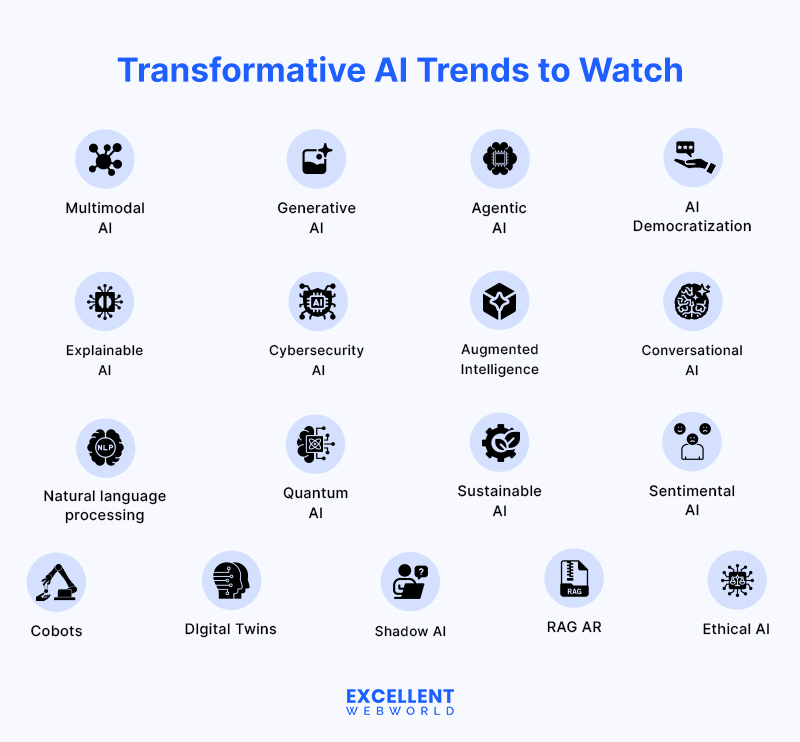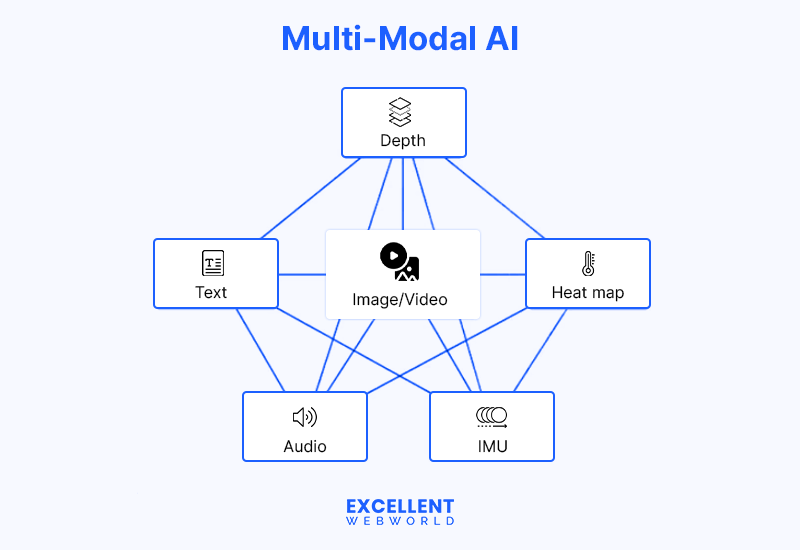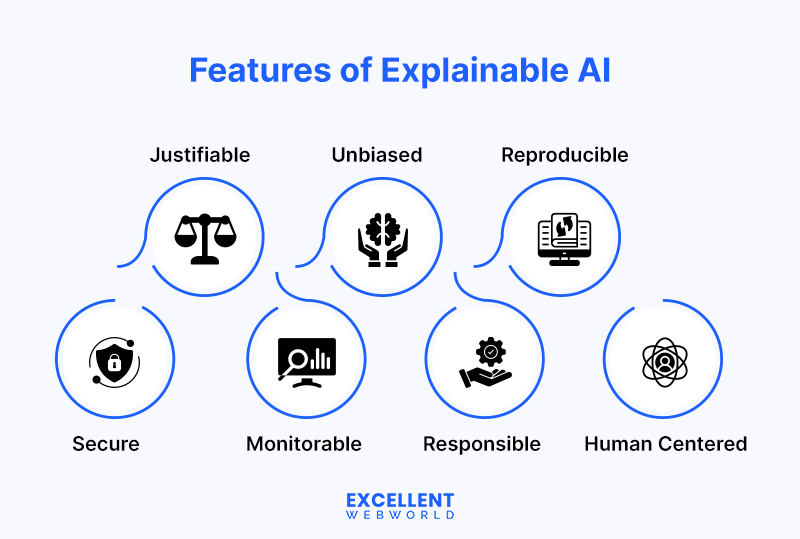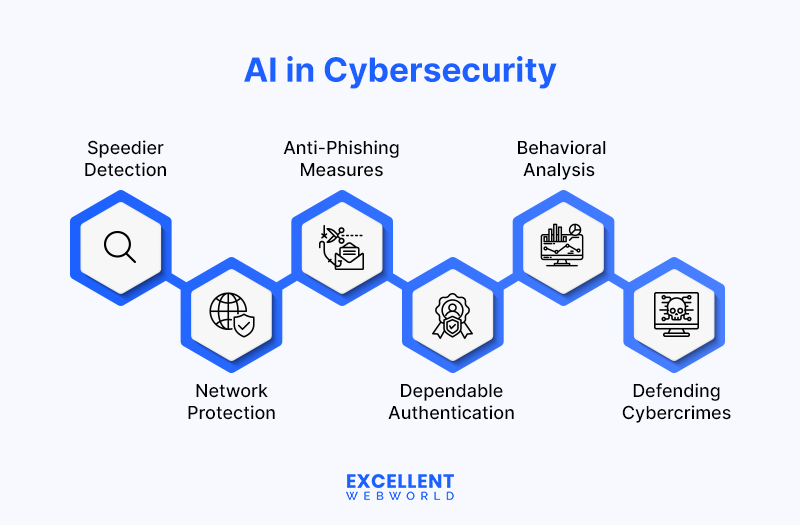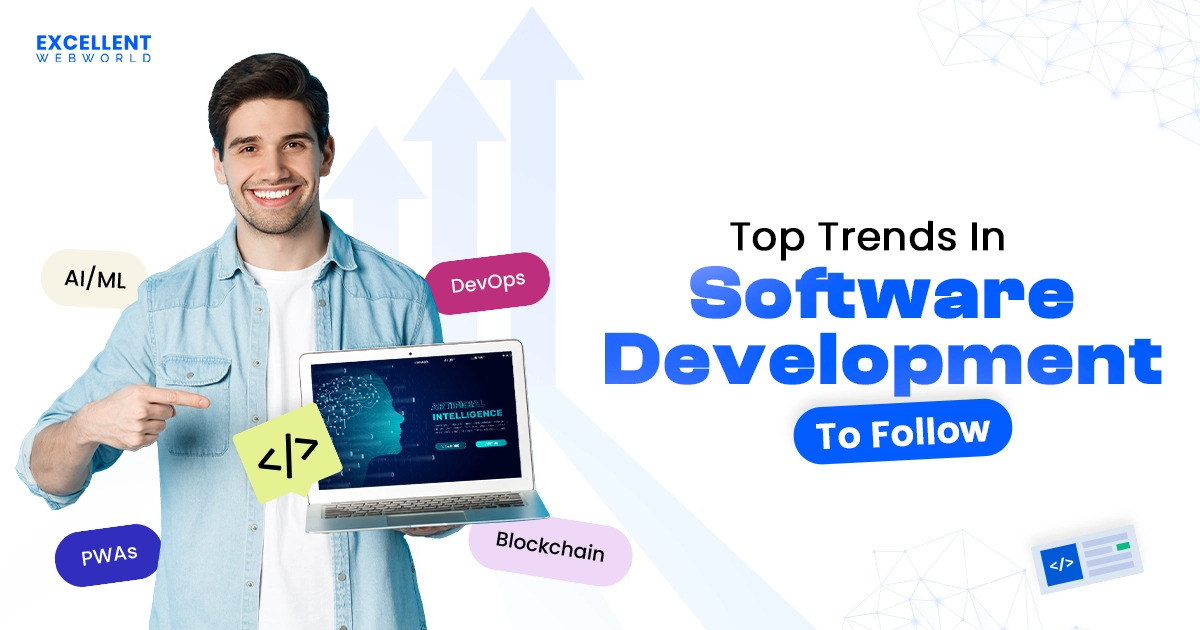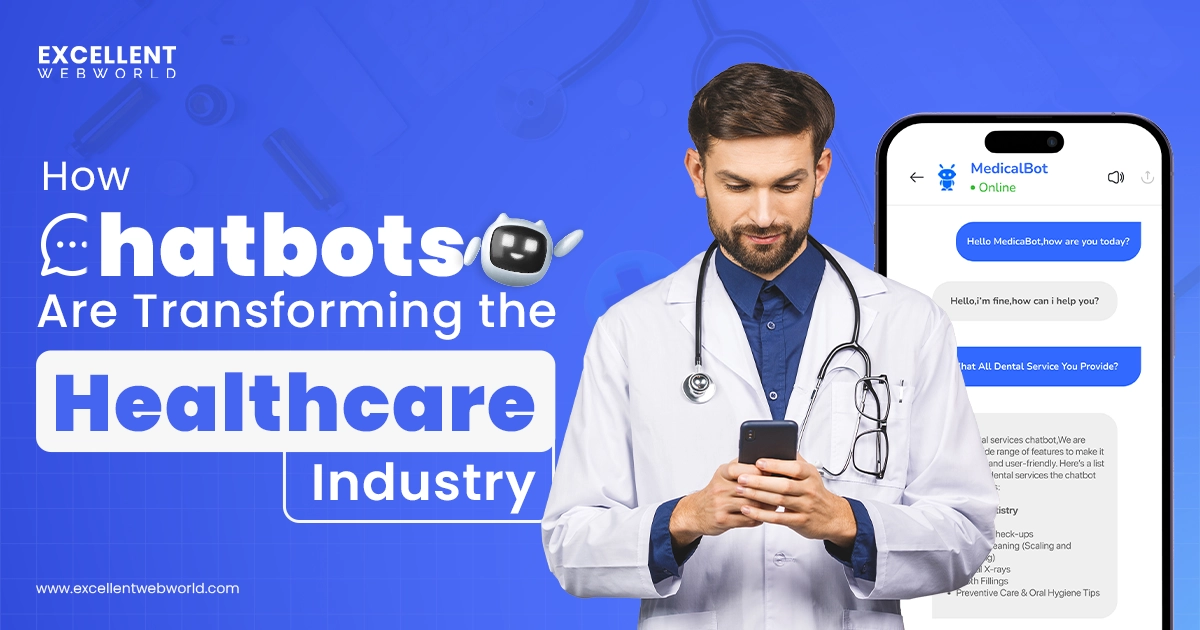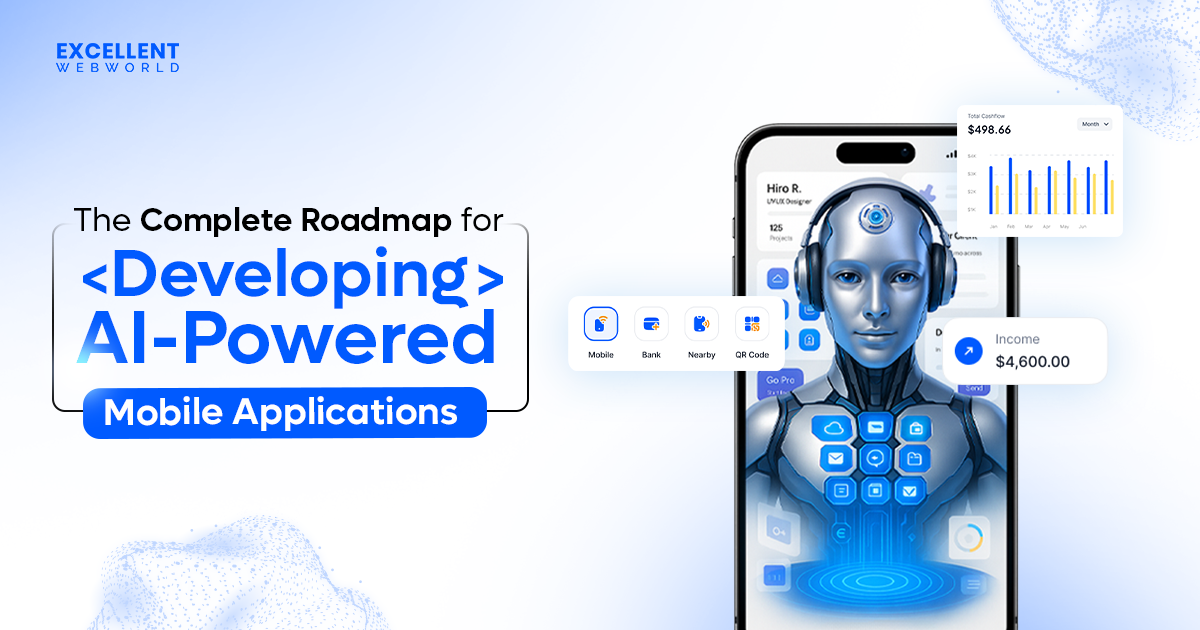If you are still “watching and waiting” on AI, you are already a step behind. The fastest-growing companies are not treating emerging AI trends like advanced tech; they are considering them as a fuel. A great fuel for faster product development, more intelligent decisions, seamless operations, and personalized customer experiences.
In 2025, the global AI market reached USD 391 billion and is projected to hit USD 1.81 trillion by 2030 at a CAGR of 35.9% (Source: GrandViewResearch). This much use of artificial intelligence is no longer just a new technology trend; it’s a takeover.
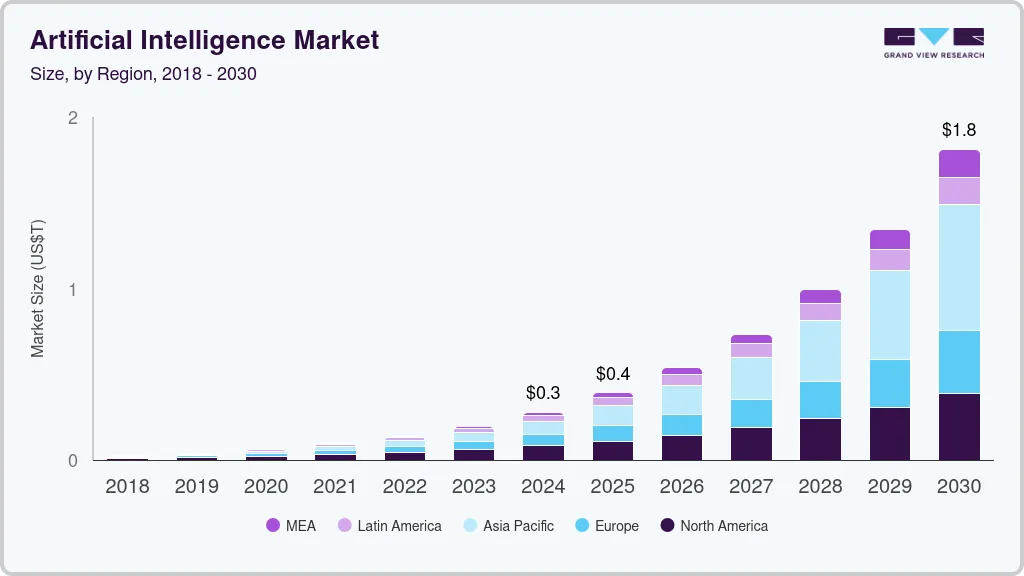
Whether it’s GenAI shaping marketing, agentic AI making autonomous workflows, or digital twins transforming how products are built, every entrepreneur should adopt AI to compete tough.
This article breaks down the top AI trends that will become the reason behind reshaping enterprises for future growth and scalability. Let’s see all seventeen AI trends 2026 and why you can’t afford to ignore them.
What Are the Must-Know AI Trends for Enterprises in 2026?
AI trends in 2026 are defined by technological advancement with generative AI, agentic AI, digital twins, RAG, an AI native app, and conversational AI to transform businesses. All these AI trends are not just buzzwords but actually help in reshaping operations, enhancing productivity, and unlocking new growth opportunities across industries. Let’s check all the key trends in artificial intelligence:
1. Multi-Modal AI
Multi-Model AI is one of the most emerging trends in artificial intelligence for businesses. It processes multiple data types, such as text, images, audio, and video, together to generate richer and highly accurate insights. Businesses can achieve better decision-making, more intuitive user experiences, and smarter automation across various industries.
Example: Meta’s ImageBind provides services to combine text, images, audio, depth, thermal, and motion data. Let’s say a retail app can use it and suggest the best outfit to a customer based on their photo, voice description, and lighting environment.
2. Generative AI
As the name of this artificial intelligence trend suggests, Generative AI creates, or we can say generates, original content like text, images, code, music, designs, or even 3D models. From marketing to software development, businesses can leverage GenAI development services to accelerate workflows, reduce costs, and innovate rapidly without spending on scaling team members.
Example: One of the popular fashion brands uses Runway ML to generate extraordinary and unique marketing videos by just giving text prompts, which ultimately reduces production time and effort from weeks to hours.
Key Use Cases of Generative AI
Pro Tip: You can embrace the advantages of Generative AI trends by starting with small internal tools (like document generators or auto email responders) to test the impact before final integration into customer-side workflows. Or, for better decision-making and right outcomes, you can partner with expert Generative AI development services providers like Excellent Webworld.
3. Agentic AI
Autonomous, goal-driven AI industry trend that acts without constant supervision.
Agentic AI refers to autonomous AI agents that have the capacity to perform goal-oriented tasks with minimal human input. Using autonomous AI agents can streamline complex business tasks such as research, scheduling, or customer support intelligently.
Businesses seeking to implement such autonomous systems partner with an AI agent development company or utilize specialized AI agent development services to design, train, and deploy agents that align with their operational goals.
Important Note: Agentic AI demands strong oversight at the beginning of the process, or we can say in the early stages. Always define guardrails and monitor outputs to avoid all the possibilities of misalignment or harmful actions.
4. Ethical AI
Moving on with current trends in AI, next is Ethical AI, which ensures transparency, fairness, and accountability in AI models. This trend helps in building consumer trust, avoiding legal risks, and aligning business practices as per the global regulations and societal values.
Example: IBM’s AI Fairness 360 toolkit assists many financial institutions in auditing their loan approval algorithm for bias across gender and race.
5. AI Democratization
The AI democratization develops powerful AI tools, which are even accessible to non-experts through no-code platforms and intuitive interfaces. It helps every team member of your organization, from marketing and HR to finance, to innovate and optimize processes without needing data science knowledge or background.
Example: A small HR team uses ChatGPT in Microsoft Word to draft job descriptions, summarize resumes, and prepare interview questions without getting any high-level certification in AI technology.
6. Explainable AI
The latest AI technology has reached Explainable AI, which makes decisions by artificial intelligence transparent and understandable to humans. For regulated sectors like finance and healthcare, AI builds trust, ensures industry compliance, and helps debug and enhance model performance.
Example: Our expert researched and suggested XAI tools like SHAP or LIME for the medical sector’s clients to explain why an AI system recommended one treatment plan over another, enabling trust and compliance with health regulations.
7. Shadow AI
The Shadow AI refers to the AI tools adopted by employees without any formal IT approval. While it boosts innovation, businesses must monitor it to make sure data security, compliance, and alignment with the company’s AI strategy are maintained.
Example: Shadow AI is like an SEO executive using the Perplexity tool to conduct web or social media query searches and provide more improvement suggestions.
8. Augmented Intelligence
Unlike the AI trend that actually replaces humans on some level, augmented intelligence enhances human capabilities. It supports decision-makers with intelligent recommendations, speeds up strategic planning with the right research, and reduces the possibilities of human errors in complex operations.
9. Conversational AI
Among the top AI trends, conversational AI enables virtual assistants and chatbots that set up the flow of natural conversations. Businesses that know how to build conversational AI can improve customer service, reduce support costs, allow 24/7 chat support, and enhance user engagement across websites, apps, and voice interfaces.
Example: Building a language learning app like Duolingo requires conversational AI to simulate real-life conversations in language learning services, which helps users to practice naturally.
Core Components of Conversational AI Trends
Pro Tip: Connect with artificial intelligence experts who provide concrete AI consulting services to make the right decisions with AI and who can also help in building hybrid conversational models (AI-assisted + human-backed) to ensure quality and trust during high-stakes or complex queries.
10. Cybersecurity and AI
AI has capabilities to enhance cybersecurity by detecting threats & suspicious activity, automating responses, and predicting vulnerabilities. Businesses use it to protect against rising attacks in real-time, ensuring their digital infrastructure remains secure and resilient.
Example: Darktrace gives cybersecurity services by utilizing AI to detect anomalies in network traffic, identifying ransomware attacks before they happen and cause any harsh damage.
11. Natural Language Processing (NLP)
NLP is the AI brain for machines to understand human language.
Natural Language Processing enables machines to read, interpret, and respond to text or any voice input. The NLP technology is the reason behind any chatbot development, language translation, and sentiment analysis.
Example:One of the popular grammar correction apps, Grammarly, uses NLP as an AI app trend to analyze and enhance the clarity, tone, and grammar of user-written content in real time.
Core NLP Functions
12. Quantum AI
The combination of quantum computing and AI is known as Quantum AI technology, which solves complex problems faster than classical computers. It holds potential breakthroughs in top industries such as logistics, finance, drug discovery, and beyond.
Example: Google’s Quantum AI helps in engineering scale-ups in software and hardware to accelerate and operate beyond classical capabilities.
You can embrace embedded software development services from Excellent Webworld experts to integrate Quantum AI technology into the embedded software or any other hardware.
13. Sustainable AI
Sustainability refers to environmentally friendly activity; similarly, sustainable AI focuses on reducing any harmful environmental impact of training and deploying models. It supports and encourages green business initiatives and optimizes energy usage without compromising on performance or future scalability.
14. Sentimental AI
The sentimental AI is one of the popular machine learning trends in AI that detects and analyzes human emotions from text, voice, or facial expressions. Mostly, it is used in marketing, HR, and customer-facing services to personalize interactions and enhance emotional intelligence in business operations tools.
Pro Tip: Hire AI developers from a top IT firm like Excellent Webworld who have a strong portfolio in building customer-facing applications and chatbots with the use of Sentimental AI that boosts your customer trust and loyalty for your business services.
15. Retrieval Augmented Generation (RAG)
The RAG AI trend enhances LLMs by allowing them to retrieve real-time data from external sources before generating any final answers. This way, RAG improves accuracy, relevance, and reliability, which is especially useful in dynamic industries such as law, healthcare, and financial services.
16. Cobots
Among the futuristic AI business trends, cobots are robots designed to work safely alongside humans. The top active industries, such as manufacturing, logistics, and healthcare, automate repetitive tasks with cobots while adapting human workflows, increasing safety and productivity.
Example: In a BMW factory, cobots work in parallel with humans on the assembly line for tasks like tightening screws and lifting parts, improving efficiency without replacing jobs.
17. Digital Twins
The digital twins are the real-time digital models of physical systems or processes that simulate, monitor, and predict the real-world behavior. In easy words, digital twins are the virtual replicas that can think, adapt, and learn from the real-world conditions.
Core Components of Digital Twins
What Are the Enterprise AI Trends and Use Cases Across Various Sectors?
The enterprise AI trends are transforming key industries, and their applications are driving innovation, efficiency, and smarter decisions. Check the following use cases table of artificial intelligence trends in business of the different sectors:
1. AI in Automotive
2. AI in Education
3. AI in Entertainment
4. AI in Fintech
5. AI in Healthcare
6. AI in Oil and Gas
7. AI in Real Estate
8. AI in Sports
9. AI in Restaurants & Hotels
10. AI in Agriculture
11. AI in Travel
12. AI in eCommerce
13. AI in Logistics
What is the Future of AI in Software Development?
AI integration in software development is revolutionizing the process of how software is built, tested, and maintained. With the help of artificial intelligence, any software or app can be developed more efficiently and productively as it accelerates delivery, reduces errors, and enables smarter, more adaptive applications. Let’s see the best ways of using AI in software building that justify the AI future trends in the software development process.
Read Also: How to Hire AI-assisted Developers for Faster Delivery?
Final Thoughts: Will AI Trends Continue to Drive Business Innovation?
The rapid adoption of AI trends is no longer a future vision or kind of possibility; in fact, it’s a present necessity. From generative creativity to autonomous agents and explainable intelligence, these artificial intelligence trends are transforming how businesses operate, innovate, and scale.
Enterprises that embrace the advantages of AI gain a competitive edge through smarter business processes, improved customer services, and data-driven decision-making.
As a leading AI development company, Excellent Webworld can be your top tech partner to enfold AI trends effectively. We help forward-thinking enterprises build customized AI-driven solutions that match their industry needs. Whether you’re exploring RAG-based search systems, predictive analytics, or AI-based automation, our team of expert AI developers turns complex ideas into real-world impact. Let’s connect to unlock the futuristic business growth together.
Frequently Asked Questions (FAQs)
Key AI trends that you can’t miss in 2026 are Generative AI, Agentic AI, Multimodal AI, RAG, Digital Twins, Conversational AI, and Sustainable AI.
Generative AI is now not limited to content creation; it grows and can perform code generation, product design, and real-time personalization with more domain-specific and enterprise-ready models.
Top industries like healthcare, fintech, automotive, education, agriculture, and eCommerce will see the most impact from AI in automation, prediction, and offering personalization.
Tools like GitHub Copilot, Midjourney, Runway ML, and Claude are trending for coding, design, video generation, and enterprise-level language tasks.

Article By
Paresh Sagar is the CEO of Excellent Webworld. He firmly believes in using technology to solve challenges. His dedication and attention to detail make him an expert in helping startups in different industries digitalize their businesses globally.

